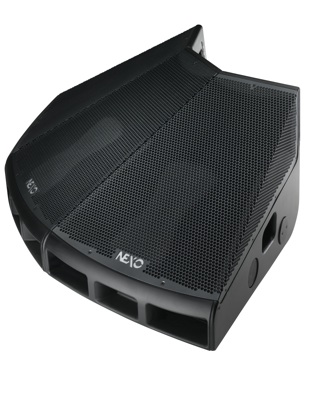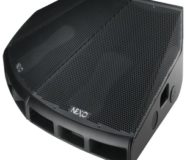In the same way that a modern line array PA system cannot be compared to a conventional point source system, the 45°N-12 line monitor cannot be compared to a conventional floor wedge.
Using a stand-alone single 45°N-12 .
45°N-12 has been engineered to provide a tight horizontal pattern control of approximately 30 degrees. When using 45°N-12 s as single units, this precise pattern control is perfect for providing a highly discrete mono mix to a stationary musician. Each performer can be provided with exactly the mix they require without affecting the mixes of the other musicians standing nearby.
The highly defined dispersion pattern makes it possible for the technician to aim the monitor sound directly at the ears of the performer and keep it away from the microphone. This provides a much cleaner sound on stage, at FOH and in the recording bus.
In situations where a stationary musician requires a stereo mix, single wedges may be used as a pair in much the same way as conventional monitors. 45°N-12 vertical coverage has been designed so that SPL level is maintained at ear level from 0 metres/feet to a distance of 2 metres/6 feet, after which the SPL level quickly drops off.
This means that it is not always necessary for the musician to be standing right on top of, or in the axis of, the wedge.
There is no “sweet spot,” as is the case with many conventional wedges.
The 45°N-12s may be placed further away from the performer than you would often place standard wedges, allowing the performer more contact with the audience and better sightlines for the audience and camera crews.
- Due to the controlled dispersion characteristics of the 45°N-12, they should NOT be used as single units when monitoring is required over a large area. In such cases, multiple 45°N-12 units should be coupled together as described below.
- Be sure to select the (1 x 45°N-12 ) controller preset when using 45°N-12 s as single units.
Using coupled 45°N-12s.
The unique hyperboloid reflective HF waveguide together with the LF patented phase directivity device allows multiple 45°N-12s to be coupled together to provide horizontal coverage and power as required while introducing absolutely no interference between cabinets.
It is important to understand that when you couple two 45°N-12s together, you have, in effect, created a single 2 x 12” monitor, but one with more power and greater coverage than a conventional 2 x 12” cabinet. A unique magnetic locking system on the cabinet sides ensures correct waveguide alignment when cabinets are coupled, allowing extremely fast coupling or decoupling of the units, according to stage configuration.
45°N-12s may be coupled together in pairs or even in threes or fours
to suit the coverage required.
For example, for a front vocalist in a high volume rock band, a standard configuration would be to use a stereo pair of coupled 45°N-12s (four monitors in total, two per side). This could be seen as being equivalent to a pair of standard 2 x 12” wedges, although the 45°N-12s will provide more power and a greater coverage area than conventional wedges.
The line-source attributes of the 45°N-12s mean that the wedge pairs may be placed further apart than conventional monitors while delivering an incredibly powerful, “open” and impressive sound field. The vocalist is free to move around a very large stage area without experiencing any change in level or tonal response from the monitors.
Due to the power and tight pattern control of the 45°N-12s, using pairs of monitors in this configuration will provide extremely high levels of monitoring between the outer boundaries of the wedges and a similar distance upstage, while greatly reducing the levels outside of this specific listening area. The lead vocalist can now have his monitor mix as loud as he likes without upsetting the other musicians on stage.
The 45°N-12 line monitors have been engineered to be LOUD, but the extremely linear response allows for higher gain before feedback than is often achievable with conventional monitors.
- When using 45°N-12s in a coupled configuration, select the (2 x 45°N-12 ) preset to compensate for the extra LF introduced due to coupling.*
Tips.
Even greater audio control is available by thoughtful selection of the 45°N-12 presets.
When using the (2 x 45°N-12 ) or (3 x 45°N-12 ) presets, the controller applies filtering to compensate for the extra LF introduced by coupling multiple wedges. This is useful, for example, when a monitor engineer is using a single wedge to monitor the mix of musicians using coupled wedges. It also means that any desired tuning applied to a single wedge can be confidently applied to coupled wedges.
The line-monitor attributes of the 45°N-12s mean that monitors may be coupled together in groups of twos, threes or fours with the groups then spaced wide apart along the front of the stage. Such a configuration will provide a consistent audio sound field right across the stage.
Out of the box, the 45°N-12 is a very “musical” sounding monitor. We receive regular reports from musicians, including many in high volume hard rock bands, that they much prefer the natural sound of the 45°N-12 s to the more “limited bandwidth sound” of many conventional monitors. However, the experienced monitor engineer should find that the 45°N-12 s respond very well to tuning, should a different sound be desired.
From the engineers…
With four musicians on stage, vocals, mandolin, acoustic guitar, 12 string guitar and snare, monitor engineer Gareth Williams says “I have absolutely no doubt that these wedges could handle a lot more than I was throwing at them. The two mixes were separated by a little more than a metre and the isolation was incredible. Given room to breathe, the wedges really shine. Absolutely perfect for the job in hand. This trial has left me with the impression that the N-12 represents VERY joined-up thinking.”
Jasen Hattams mixed monitors for all the bands at this year’s Cropredy electric folk festival. “I had not one complaint from 20 or more bands over the weekend, and I was pleased with that as some of the changeovers between bands took all of 10 minutes. Lots of bands complimented us on the monitor sound. I would love to take all the credit but alas, I cannot; the “big shoe” wedges, as the local crew nicknamed them, did a great job and dealt with everything I threw at them, from acoustic fiddles, banjos and a harp to the raging onstage sound of the Horslips. The only real issue I had was that there were only ten wedges when I really needed twenty.”
Chris Wibberley, monitor man for Ray Davies, has been using two NXAMPs to drive four 45°N-12s. “Because of the way the units couple, the N-12s act as a single source. They sound absolutely fantastic! The problem with a lot of wedges is that they can sound too clean and hi-fi. But these have a bark to them. They’re still rock ‘n’ roll but they sound like a wedge doing what it is supposed to do.”

















































